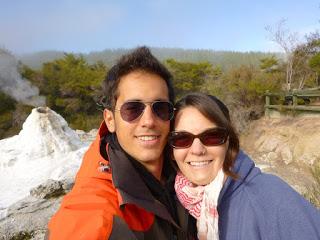
Click here to read the English version
Como explicamos en la última actualización el clima por aquí es tremendamente bueno de lunes a sábado. Los domingos toca lluvia y frío. Bien, mi cumpleaños fue el domingo pasado y ni nos molestamos en mirar la predicción meteorológica: decidimos celebrarlo el sábado, pero no lo pensamos muy fuerte por si se enteraban las nubes y decidían venir antes; con ellas nunca se sabe.
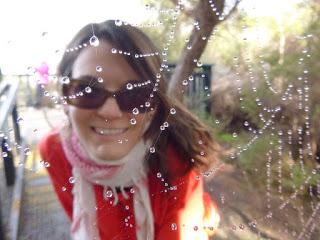
Nick nos dejó un coche así que el sábado, a las seis de la mañana, salimos rumbo al parque geotermal de Wai-O-Tapu. Teníamos tres horas de viaje hasta la zona de Taupo y Rotorua, que es donde está el parque. Ahí habíamos quedado con Elena, amiga mía desde que coincidimos en el parvulario y el colegio.
Nueva Zelanda, igual que Japón, California y la costa oeste de Sudamérica, forma parte del Cinturón de Fuego del Pacífico, que contiene el 75 % de los volcanes activos e inactivos de la Tierra. De hecho, Nueva Zelanda se encuentra en la frontera entre la placa tectónica Indoaustraliana y la Pacífica, he aquí el motivo de los frecuentes terremotos que sufrimos por estos lares. ¿A qué viene todo esto? Pues precisamente a que en la zona de Taupo y Rotorua este hecho es más que evidente, motivo por el cual es aquí donde se rodaron las escenas de Mordor en El Señor de los Anillos. Próximamente intentaremos ir al Monte del Destino, conocido aquí como Tongariro.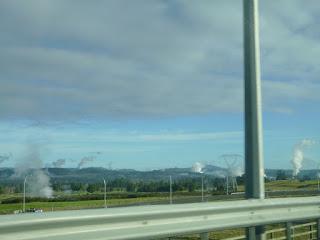
A medida que nos íbamos acercando a nuestro destino nos dimos cuenta de la particularidad de esta zona. El suelo humeaba como si el comepiedras subterráneo estuviese preparando una fabada y el aire olía a huevos podridos, como si el comepiedras subterráneo se hubiese comido ya esa fabada.Géiser Lady KnoxEl Lady Knox era nuestro punto de encuentro con Elena y su familia. Este Géiser fue descubierto en el año 1901 por un grupo de presos de la cárcel abierta de Rotorua. No sabemos exactamente cómo funciona esto de las cárceles abiertas pero parece que los presos iban y venían como querían. En una de estas excursiones un grupo de presos se dispuso a lavar su ropa en un charco de agua caliente. Cuál fue su sorpresa cuando, al añadir jabón al agua, ocurrió algo similar a cuando se vacía un paquete de Mentos en una botella de Coca Cola.
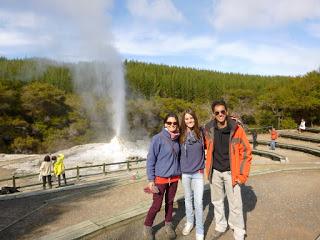
Después del susto de la primera vez, los presos apilaron piedras alrededor del géiser formando un cono y empezaron a pasárselo pipa tirando jabón para que entrara en erupción. Al cabo de unos años el Departamento de Conservación de Nueva Zelanda pasó a hacerse cargo del Lady Knox. Construyeron unas gradas alrededor del géiser y hacen que entre en erupción cada día a las diez y cuarto de la mañana gracias a un jabón orgánico especial que no daña el medio ambiente. Nos lo creeremos. Evidentemente hay que pagar por verlo, pero vale la pena si nunca has visto un géiser.
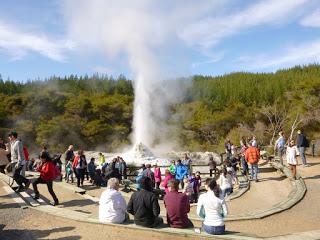
Wai-O-TapuEntrar al parque geotermal es una actividad de riesgo extremo, si hacemos caso de todas las advertencias que tienen por ahí distribuidas. Los gases que salen del suelo están a más de cien grados centígrados por lo que si te acercas mucho te abrasarás, algunas de las lagunas contienen ácidos altamente corrosivos por lo que si tiras una piedra y te salpicas encima se te derretirá la piel y se te caerá a tiras provocándote una agonía terrible, fumar está terminantemente prohibido ante el riesgo de que los gases se incendien y explote el planeta Tierra y la Luna de rebote. Esto último no es tan drástico pero sí es cierto que está prohibido fumar ante el riesgo de hacer explotar la zona.En el subsuelo hay una red de ríos subterráneos cuya agua se calienta gracias al magma sobrante de las últimas erupciones habidas en la zona (la última del volcán Tarawera en 1886), habiendo llegado a alcanzar temperaturas de 300 grados centígrados. El agua está tan caliente que disuelve los minerales de las rocas que atraviesa y los transporta hasta la superficie en forma de vapor de tal forma que gran parte de estos minerales son absorbidos por el suelo.
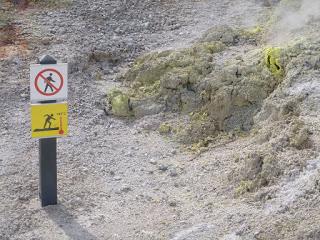
El parque se recorre en un par de horas caminando por una especie de paseo que el Departamento de Conservación tiene preparado.
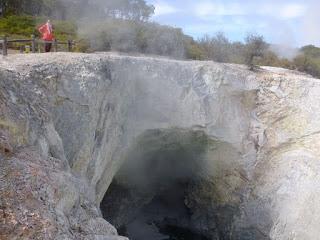
Es curioso como las personas tenemos tendencia a poner nombres de temática diabólica a cuevas grandes o grutas oscuras. Claro que esto en países como España o Andorra es a nivel de aficionados. Este parque es, junto a Yellowstone, de primera división demoníaca: lagunas sulfúricas burbujean por toda la zona ya sea en la superficie o en el interior de grutas o cráteres, por lo que aquí nos encontramos con “la casa del diablo”, “los tarros de tinta del diablo”, “el cráter del infierno” y hasta con “el lavabo del diablo”.
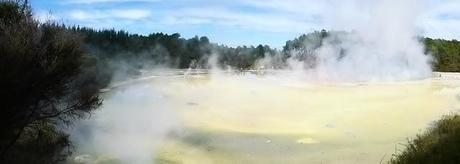
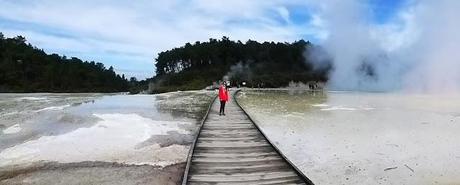
De todas formas uno de los lagos más espectaculares no está relacionado con Don Diablo sino con el dios Baco. Estamos hablando de “la piscina de Champán”.
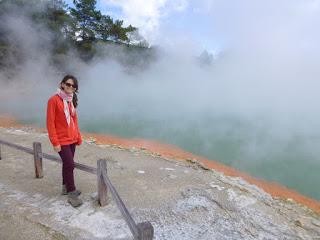
Es un manantial natural de 65 m de diámetro y 62 m de profundidad. La temperatura de su superficie son 74 grados centígrados y burbujea debido al dióxido de carbono que desprende. El agua contiene oro, plata, mercurio, arsénico, azufre, talio, antimonio y más elementos de la tabla periódica que no han querido poner en el tríptico que te dan al entrar.

El color naranja de la orilla está causado por la presencia de antimonio, obviamente.

Después de “la piscina de Champán”, el camino lleva hasta “la llanura de la sartén”, que básicamente es un cráter lleno de manantiales de azufre y demás peligros mortales para todas las especies del mundo mundial excepto para las gaviotas locales, que se alimentan de los insectillos que se atreven a sobrevolar estas aguas.
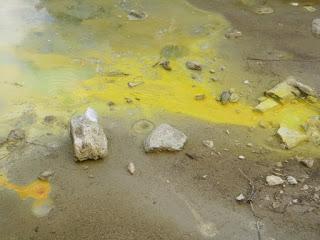
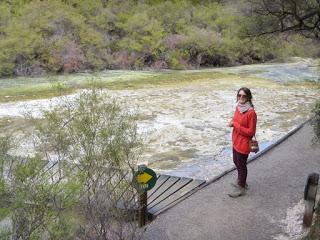
Siguiendo el recorrido llegamos a una pequeña cueva en la que parece que al portero se le ha ido la mano con el azufre para que los perros no hagan pis. Efectivamente, se llama “la cueva de azufre”. Ante todo creatividad.
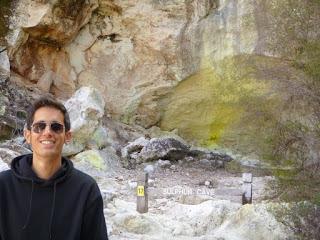
Avanzando hacia la mayor sorpresa del parque nos encontramos con “el cráter del infierno” donde uno mira hacia el fondo intentando ver a algún famoso dictador tostándose. No hubo suerte, debían estar todos en “el cráter del arco iris”, también en Wai-O-Tapu. Al fondo del “cráter del infierno” hay una laguna de barro hirviendo violentamente (así lo describen en el tríptico informativo) que libera gases corrosivos. Hasta hace unos años había una especia de arco rocoso que pasaba por encima del cráter, pero estos gases lo disolvieron. Toma ya.
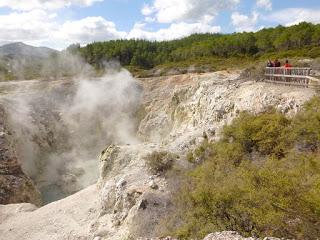
Y por fin, casi antes de salir del parque, nos encontramos con el lago que da respuesta a una de las dudas más inquietantes que jamás hemos tenido los que subrayamos con fosforito.
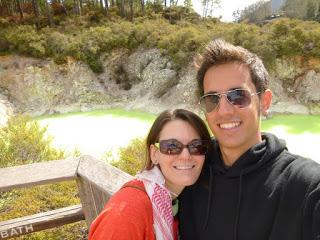
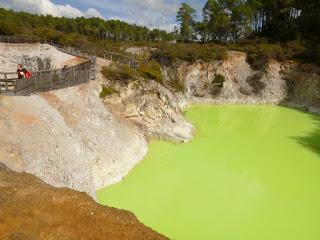
Efectivamente, en las fotos superiores se puede ver el manantial que utilizan los de Stabilo y Staedtler para sus subrayadores amarilloverdosos. La piscinita es conocida como “la bañera del diablo” y es un cráter que se llena con el agua sobrante de “la piscina de Champán”, que al mezclarse con las sales de hierro y azufre del terreno le dan este color tan característico. Kerosene Creek¿Qué es lo que más apetece después de ver tantos lagos diabólicos? Un baño, por supuesto. ¿En agua fresquita? No necesariamente ya que aquí estamos en invierno. ¿Qué tal queroseno?
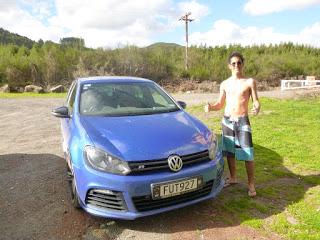
Con estos pensamientos nos dirigimos hacia el Kerosene Creek, que significa el arroyo queroseno. ¡Pero no temáis! El riachuelo es de agua caliente, lo de queroseno viene por el pestazo que hace, cosa que consigue que parezca que te estás duchando con Súper 95.
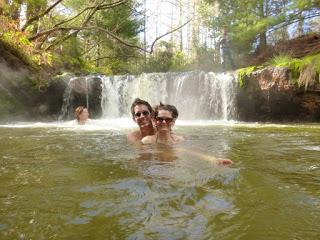
Así entre guiris que se habían llevado un barril de cerveza y domingueros como nosotros nos dimos un baño junto a unas pequeñas cataratas. La experiencia es relajante estilo jacuzzi, pero el olor con el que sales llega a ser mareante. Una vez te secas el olor es parecido al de goma quemada.
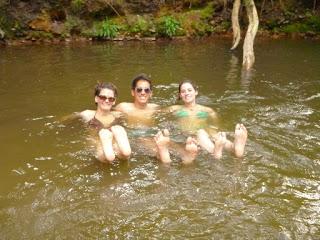
El barro burbujeanteAntes de dirigirnos a Rotorua, la ciudad donde íbamos a pasar la noche, nos fuimos a ver un lago de barro burbujeante.
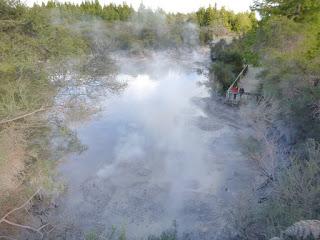
Espectacular. Básicamente parece un lago de Cola Cao hirviendo que alterna momentos de relativa calma con otros de mal humor. Las burbujas se concentran a unos metros de la orilla y son tamaño pelota de tenis o de fútbol, según le dé al gas.
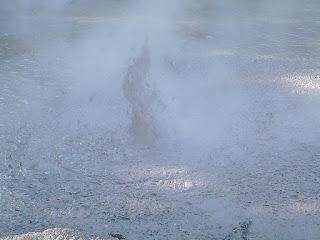
El olor es insoportable y el lago suena como una cazuela haciendo “chup-chup”. La verdad es que da un poco de miedo porque a veces parece que el lago entero va a entrar en erupción.
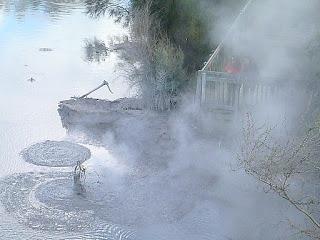
RotoruaRotorua es una pequeña ciudad construida encima de un yacimiento de peste apestosa y rodeada de manantiales de agua caliente también apestosa. Obviamente su principal fuente de ingresos son los balnearios y, en cuanto al olor a sulfhídrico, te acostumbras. No hay mucho que hacer si no quieres gastarte un dineral así que nosotros optamos por subir una montaña.
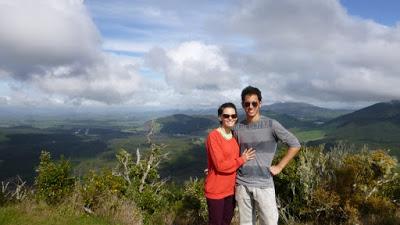
Era domingo así que llovió. Pero tuvimos la suerte del cumpleañero y las nubes se esperaron a que llegásemos al coche para descargar su furia. La montaña, llamada Maungakakaramea (Arco Iris), es la frontera norte de Wai-O-Tapu, motivo por el cual da la impresión de ir a explotar en cualquier momento.

Y esta ha sido la historia de cómo celebramos mi 26 cumpleaños. ¿Muy bien, no?Enrique & MarinaEnglish version
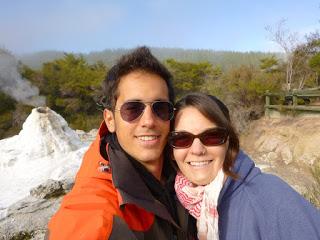
As we wrote in the last entry, the weather in Hawke’s Bay is fantastic from Monday to Saturday. On Sunday it’s cold, windy and raining cats and dogs. Well, Enrique’s birthday was the last Sunday and we couldn’t be bothered checking the weather: we decided to move it on Saturday but we couldn’t talk about it too loud, just in case the clouds would hear us and decide to come earlier. Do not ever trust the clouds.
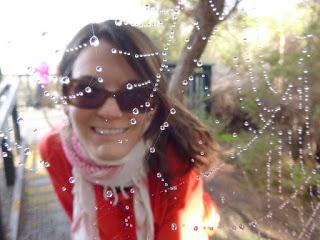
Nick was a legend and let us his car. At 6 a.m. on Saturday we woke up and bounded for the Wai-O-Tapu geothermal park, half way between Taupo and Rotorua. We had at least three hours journey to get there. In the park we’ll meet Elena, Enrique’s friend since they were toddlers and went to the same kindergarten. New Zealand, as well as Japan, California and the west coast of South America, is placed in the Ring of Fire, which is an area containing 75% of the active and dormant volcanoes on Earth in the basin of the Pacific Ocean. In fact, New Zealand is located in the junction of the Indo-Australian tectonic plate and the Pacific plate which is the reason of the frequent quakes shaking the country. Why are we telling you all that? Well, because this geological feature is more than obvious particularly in the area of Taupo and Rotorua. Therefore, the scenes of Mordor in the Lord of the Rings where shot in this region. In short, we will go to visit the Mount Doom of the Lord of the Rings, known as Tongariro in real life.
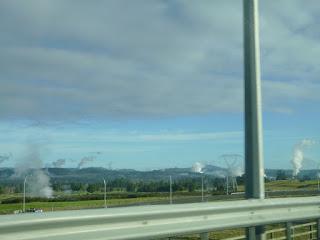
As we approached our destination we discovered the particularities of the place. The ground smokes as if a huge underground monster was preparing some cauliflower soup and the air smells as if the same monster had already eaten it.Lady Knox geyserThis geyser was the meeting point to see Elena and her family. The Lady Knox was discovered in the year 1901 by a group of prisoners of the Roturua open jail. We’re not sure about how a facility like this works, but it seems like the interns wander around quite free. During one of these wanders, a group of prisoners was doing some washing in a puddle of hot water. Surprisingly, the effect as they added soap was similar to the reaction after emptying a package of Mentos in a bottle of coke.
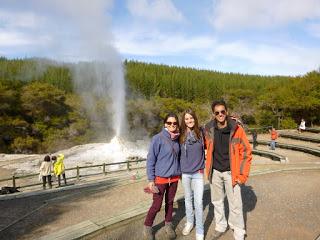
After the first fright, they built a little conic-shaped wall surrounding the hole and started having fun throwing more soap to make it erupt. After a few years, the Department of Conservation of New Zealand (DOC from now on) took over the Lady Knox geyser. They built some terraces and now they use an environmentally friendly organic soap to make it erupt daily at 10.15 in the morning. Thus all the visitors who choose to pay the entry fee can conveniently enjoy the show, which is worth it especially if you have never seen a geyser, like us.
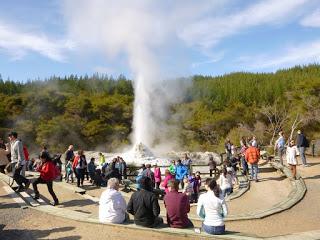
Wai-O-TapuEntering the park is a high risk activity judging by all the screens alerting about the different dangers. The gas coming through the ground is hotter than 100 degrees so don’t get too close of you’ll burn yourself. Some of the pools are full of highly corrosive acid so don’t throw stones or anything because your skin will melt if you splash you up. Smoking is completely forbidden not only because of your health but also because you may ignite a bubble of gas and the Earth may explode and the Moon too, as domino effect. Well, this last one might be slightly theatrical, but smoking was actually forbidden in the park as real explosion hazards exists.Seriously, there’s a network of rivers underground which gets hot using the magma leftover since the last eruptions (the last one was the volcano Tarawera in 1886), reaching temperatures up to 300 degrees. This water is so hot that dissolves the minerals as it goes through the rock and brings them to the surface as gas, thereby most of the components get stuck in the ground.
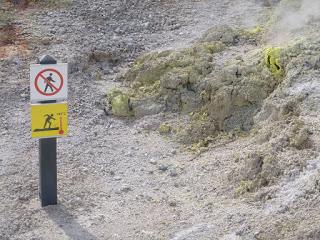
The park can be completely seen in a couple of hours walking on a path that the DOC has settled.

It’s funny how people tend to give devil related names to big caves or dark caverns. Well, in Spain or Andorra we do that at a beginner’s level, anyway. Wai-O-Tapu is, with Yellowstone, on the Satan’s premiere league: bubbling pools everywhere, on surface or inside caves or craters. So, in the park we found the “Devil’s Home”, the “Devil’s Ink Pots”, the “Inferno Crater” and even the “Devil’s bath”.
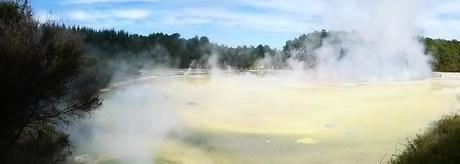
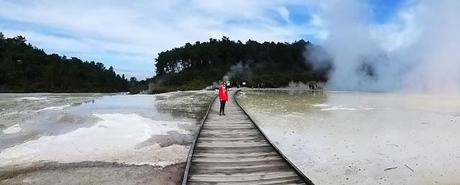
Despite all this evil names, one of the most scenic lakes wasn’t related with the Prince of Darkness but with the god Bacchus. We’re talking about “the Champagne Pool”.
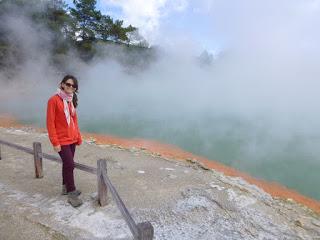
This is the largest natural spring in the district, being 65 m in diameter and 62 m deep. Its surface temperature is 74 degrees and bubbles are due to released carbon dioxide. Its water contains minerals such as gold, silver, mercury, sulfur, arsenic, thallium, antimony and other elements of the periodic table that they didn’t write in the leaflet they give you because only PhDs in chemistry know about them.
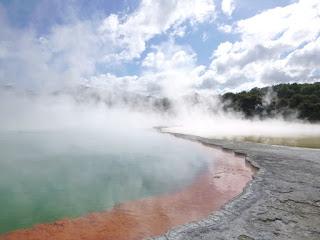
Obviously, the orange color is caused by the presence of antimony.
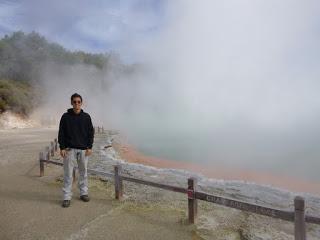
After “the Champagne Pool” the path takes you to the “Frying Pan Flat”, which is basically a crater filled by hot springs of sulfurous water and other deadly dangerous chemicals for any living creature, but the local Pied Stilts (sort of seagulls) which eat the insects that are brave enough to fly over these waters.
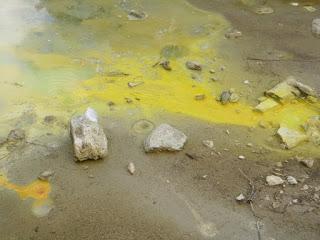
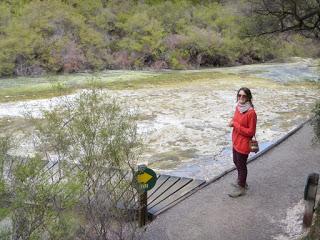
Walking forward on the path, there’s a little cave that looks like the property keeper has covered with sulfur to avoid any dogs on the whole planet to pee on the wall. Quite so! The cave is called “Sulfur Cave”, not a really creative name.
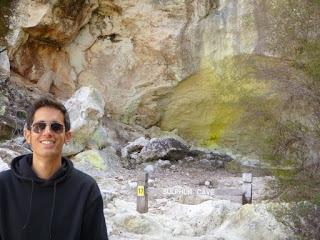
Approaching to the greatest surprise of the park we found the “Inferno Crater” where we expected to find an old dictator or two getting golden at the very bottom. No luck, we didn’t find anyone. Maybe they were in the “Rainbow Crater”, located in Wai-O-Tapu, also. The “Inferno Crater” has a bottom of violently boiling mud (as literally describes the park leaflet). Apparently, in recent history (we don’t know how many years ago is that) an earth archway linking the sides has been completely destroyed by the action of acidic steam. Wow! How’s that?
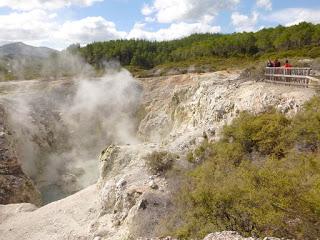
Finally, before leaving the reserve, we found a lake that was the answer to a question that everyone who uses highlighters asks themselves.
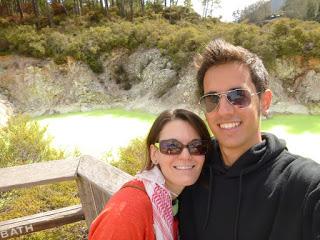
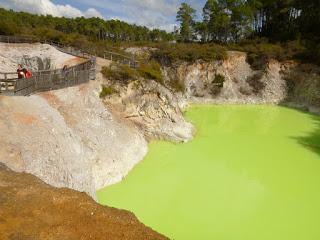
Exactly, in the pictures above you can see the spring that the people in Stabilo or Staedtler use to fill their markers with yellow-greenish bright ink. This pool is known as the “Devil’s Bath” and its color is the result of excess water from the “Champagne Pool” mixing with sulfur and ferrous salts. Kerosene CreekSo, what did we feel like doing after all the devilish sightseeing? A nice bath, of course. Cold water? Not really, it’s winter in the south hemisphere! What about kerosene?
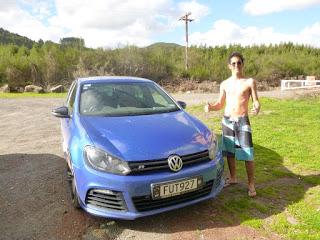
Looking forward to that we drove to the Kerosene Creek. But, don’t worry; it’s just a hot spring and not real kerosene. The name might be related with the stink, it’s quite like if you were swimming in premium petrol.
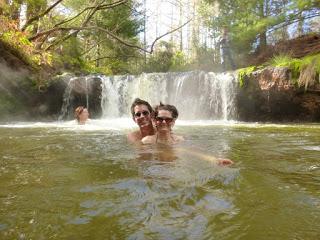
Never mind, we had a pleasant bath next to a little waterfall with other tourists carrying a beer barrel and some locals coming from a bike trail. The experience was pretty relaxing as a spa but we ended up smelling like rotten eggs. Once we were dry the smell changed to burnt gum.
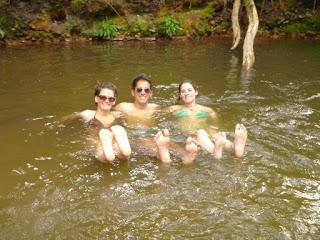
El barro burbujeanteBefore going to Rotorua, where we spent the night, we visited a big bubbling mud lake.
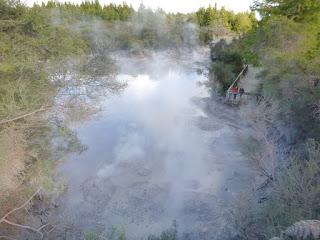
Amazing. It basically looks like a pot with boiling Milo that combines relatively calm and very rough moments. The bubbles emerge mainly close to the edge and their size ranges from tennis to soccer balls, depending on the mood of the mud.
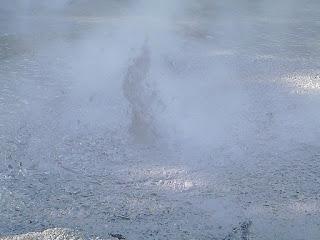
Here the smell is overwhelming and the sound it’s exactly like a boiling pot. It’s a bit scary it you think about it because it seems like the whole lake is about to erupt and the ground where you’re standing will collapse.
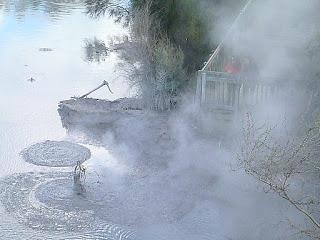
RotoruaRotorua is a small town built on top of a deposit of stinking stink and surrounded by hot and also stinking water springs. Obviously, the first’s money sources of the city are all the bath houses and the tourists. About the smell, you get used easily. There’s not much to do in the city unless you want to spend a fortune, so we choose to climb a mountain, which is still free.
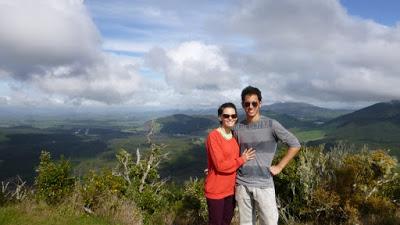
It was Sunday so it rained. But we had the birthday-boy luck and the clouds waited until we reached the car back to vent their anger. The mountain, called Maungakakaramea which means Rainbow, is in the border of Wai-O-Tapu and once upon a time it was a volcano.
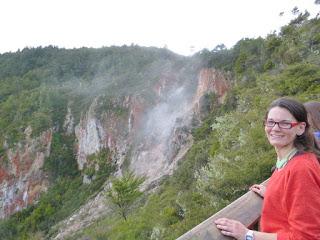
And this is the story about Enrique’s 26th birthday. Pretty good, eh?
Enrique & Marina
